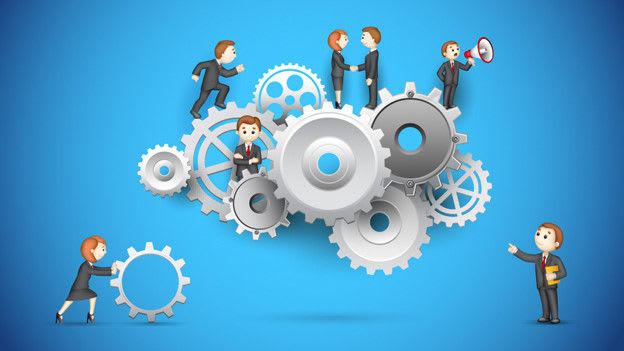![]()
Ensuring safety and hygiene, managing psychological fear, dealing with change, and implementing flexible work arrangements are some key challenges organisations grapple with as they create a plan to lead successful transitions to return to office or workplace. With the employees now comfortable with the work from anywhere arrangements, it is now a big change management drive that HR leaders need to plan for. The approach to work has tremendously evolved. Going back to the old ways is definitely not the option and as various reports clearly highlight, doing so will cost organisations their top teams.
In response to the shift in talent priorities and demand for greater flexibility, organisations are majorly looking at a gradual transition plan, and currently leveraging hybrid workplace models. The same thoughts echoed in the fireside chat at Day 3 of People Matters TechHR India 2021 conference as well. Carey Pellock, EVP & CHRO at Neustar; Nanda Rackanchath, CHRO at Tata Chemicals, and Vipul Singh, Divisional Vice President and Head of HR at ADP shared how creating a work ecosystem which suits the diverse needs of employees is critical to business.
Ensuring employee well-being: Creating a safe place work
The psychological fear of the virus spread has not gone away because it still exists and with new variants being detected the situation has worsened. Even though vaccination drives have begun, the health and safety protocols still need to be adhered to which means taking care of the infrastructure, managing social distancing, planning the work schedules, and creating compliance policies which should be strictly followed.
“Hence, the focus for HR leaders needs to be on enhancing Workplace Readiness,” shared Nanda. These need to be looked at from two perspectives, one for the facilities completely owned by companies, where it is easier to ensure all safety measures are implemented. However, in shared spaces, co-creating that infrastructure and ensuring compliance is more challenging. That needs careful attention. From security to housekeeping to administrative, all elements have to be in place to ensure workplace readiness for return to office transition.
Another challenge Nanda highlighted is ‘Mobility Readiness’. If the employees depend on public transportation to commute, the health and safety of their employees is not under the radar of the organisation. Additionally, the costs of organising personal transportation of everyone and managing the entire logistics is also daunting. So the organisations need to look at it from a more holistic perspective and reflect how ready they really are to welcome their people back to work from office?
Driving change management: Dealing with shifts in attitudes & mindsets
Vipul highlighted how employees are now comfortable working at their own pace, at ease from their home or anywhere. They don’t have to dress formally all the time. They are saved from the hassle of commuting. Many of them wouldn’t want to completely let go of that. If organisations plan a return to the workplace that means totally dismantling the work mode everyone is now accustomed to and is enjoying. However, as evident from various surveys, some people want to return to office as well. Either they are missing the personal connection or they want to break from the new routine.
Managing this sheer change is what Nanda referred to as ‘Employee Readiness’. To begin with, the concern is if employees are physically ready to join back office, which largely focuses on getting vaccinated, getting the families vaccinated. Hence, we can see many companies organising vaccination camps for their employees and respective families. That’s primary.
The second layer is being mindful of the diverse personal scenarios employees could be in. In these last one and half years, many new people have also joined in and some previous employees have also moved to other locations. So scenario one is: do they wish to come back or would they rather work remotely? In another example, Nanda spoke about the caregivers which form a percentage of your talent pool. They would want to hold onto the flexibility of working from home too.
Building a connected workforce and taking care of employees’ mental health
As we address how all of us are in the same storm but not in the same boat, one of the biggest challenges for HR leaders is to manage the varied needs of the diverse and dispersed workforce. On top of that, they also have to ensure that in this hybrid work model, where a percentage of people work from office and other from home/anywhere, they create the same deep level connections and drive collaborations. Here’s where technology plays a key role.
Carey shared, “Now that people are starting to return, we have to be more mindful of new vs old ways of working. For instance, instead of the dining room having breakfast, you will now find people in their car in the morning. You can’t expect the person to drive and text. So employees in different locations and situations have to be empathetic and respectful to each other’s space and time.”
But the best part, as Carey mentioned is, we are on a learning journey and there is no rule book to lead this transition. The best way is to learn together.
How useful was this post?
- Share review with rating here: Google Review
We are providing practical training (Labor Laws, Payroll, Salary Structure, PF-ESI Challan) and Labor Codes, Payroll Consultant Service & more:
- HR Generalist Practical Training: https://oneclik.in/hr-generalist-practical-training/
- Labor Law + Payroll-Practical-Training: https://oneclik.in/labor-law-payroll-practical-training-certificate/ (PF, ESI, Bonus, Payroll & more)
- Labor Code, 2020 (Crash Course): https://oneclik.in/labor-code2020-rules-practical-training-certificate-crash-course/
- Labour Code | Labour Bill (Labour-Law-Practical-Training): https://oneclik.in/labour-law-practical-training/ (Factory, Contact Labor, Maternity Act & more)
- PF – ESI Consultant Service: https://oneclik.in/pf-esi-consultant-service/
- Labor Law, Compliance & HR – Payroll Management
- Advance Excel Practical Training: https://oneclik.in/advanced-excel-practical-training-certificate/
Get Latest HR, IR, Labor Law Updates, Case Studies & Regular Updates: (Join us on Social Media)
- Telegram Channel: “One Clik”
- Whatsapp Group: https://wa.me/919033016939
- Facebook: One Clik
- Linkedin: One Clik
- Instagram: oneclik_hr_management
- YouTube: One Clik

